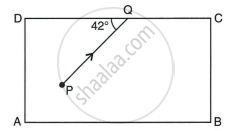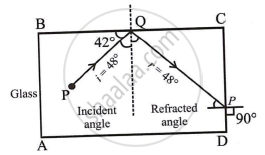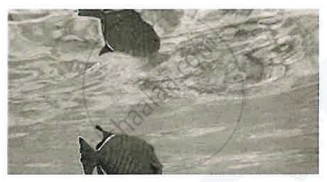Advertisements
Advertisements
Question
The diagram below shows a light source P embedded in a rectangular glass block ABCD of critical angle 42°. Complete the path of the ray PQ till it emerges out of the block. [Write necessary angles].

Solution
Given, critical angle, C = 42°
At a point Q, i = 48° and iC = 42°
i.e. i > iC
r = 48°
At a point P, i = 42° and iC = 42°
i = iC
Therefore, r = 90°

APPEARS IN
RELATED QUESTIONS
You are given prisms made of crown glass and flint glass with a wide variety of angles. Suggest a combination of prisms which will
(a) deviate a pencil of white light without much dispersion,
(b) disperse (and displace) a pencil of white light without much deviation.
A ray of light travels from water to air as shown in the diagram given below :

1) Copy the diagram and complete the path of the way. Given the critical angle for water is 48°.
2) State the condition so that internal reflection occurs in the above diagram.
Name the factors affecting the critical angle for the pair of media.
Draw the diagram of a right-angled isosceles prism which is used to make an invented image erect
(i) Define critical angle.
(ii) State one important factor which affects the critical angle of a given medium.
Plot a graph between
Sine of angle of incidence versus sine of angle of refraction,
Make the correct choices for each of the following :
Total Internal reflection takes place when
(where ∠i = angle of incidence, ∠r = angle of refraction, ∠C = critical angle)
Answer the following question.
Under what conditions are total internal reflection possible? Explain it with a suitable example.
Optical Fibres are based on the phenomenon of dispersion.
The diagram below shows a fish in the tank and its image seen in the surface of water.

Name the phenomenon responsible for the formation of this image.
